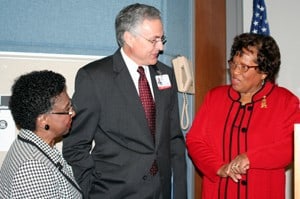Diversity Can be a Strength in Changing Health Care, Says Elders
| Sept. 28, 2010 | When Joycelyn Elders, M.D., began medical school at what is now the University of Arkansas for Medical Sciences (UAMS) in 1956, she was one of just three African-American students. “We’ve made some real changes,” said Elders, the former U.S. surgeon general and UAMS professor emeritus of pediatrics in the College of Medicine, noting that current enrollment includes more women and more minority students. “But we are still a work in progress.” Elders spoke at UAMS to kickoff annual Diversity Week activities celebrating the diversity of employees and students. She said it was that diversity of backgrounds and experiences that poses health care challenges but can also be a strength for tackling some of those challenges. Elders said she asked her brother, a pastor, for some guidance on what she should say about diversity. She said he responded by asking her in what language her patients hurt in, which got her thinking. “Even though we’ve become a very diverse population, all of our patients hurt exactly the same,” she said. Using health care statistics, Elders painted a picture of a country that is getting older and is eating more while exercising less. Americans are being plagued by more chronic health conditions, such as diabetes, while making some improvements in lowering preventable causes of death. While more than 50 million Americans lack health insurance, she said, Americans spend more on health care as a percentage of gross domestic product than any country in the world. “We’ve got the best sick care in the world – if you get very sick, you’ll be cared for,” Elders said. “It’s our health care that isn’t what it needs to be.” The diversity of cultures, languages, age, sexual orientation, socioeconomic status and education can pose challenges to delivering the kind of health care that meets the needs of patients, she said. Elders told a story from her days on the faculty when a patient walked from Helena in east Arkansas to be seen for a pain in his head. A secretary told him that he could not be seen because it was late on a Friday and the doctors were gone. A neurosurgeon who happened to pass by heard the commotion and saw the patient – who ended up having a brain tumor. The patient was operated on that Saturday morning and recovered completely. Poverty, distance or cultural differences should not be a barrier to care, she said. Cultural competency, which she defined as behaviors and strategies that address the differences posed by diverse backgrounds can bridge those barriers, Elders said. Using resources such as interpreters for non-English-speaking patients or even knowing not to schedule early morning appointments for patients who must come from long distances are elements of cultural competence, she said. Health promotion should be done in a way that reaches the specific audience regardless of cultural differences. Education – both for health care providers and patients – can improve health literacy and understand the difficulties some patient may have in understanding the care they receive. “How many of our patients are here because they didn’t take their medications correctly?” she wondered. Elders said recruiting more minority students, training providers to work with patients from different backgrounds and working more closely with family and community health workers in the care of patients can help address cultural barriers to care. Making those changes can allow a shift from cultural competence to cultural proficiency, she said. |
